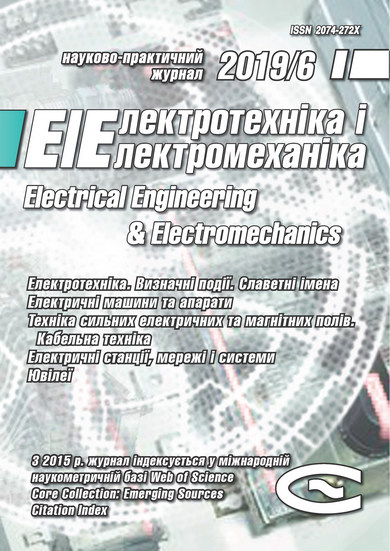NUMERICAL ESTIMATES OF CURRENTS AND FORCES IN LINEAR TOOLS OF THE MAGNETIC-PULSE ATTRACTION OF METALS. PART 2: HIGH ELECTRICAL CONDUCTANCE METALS
DOI:
https://doi.org/10.20998/2074-272X.2019.6.05Keywords:
metals with high electrical conductance, intensive field penetration, magnetic-pulse attraction of conductors with unidirectional currents, linear tools for eliminating dents in body coatingsAbstract
Purpose. The purpose of the present work is substantiating workability of the linear tools of the magnetic-pulse attraction of thin-walled sheet metals with high electrical conductance, the principle of which is based on the force interaction of two conductors with unidirectional currents during intensive penetration of the acting electromagnetic fields. Constructively, one of these conductors in the linear tools is the so-called main current lead (an analog of the inductor in EMF) and the second one is the part of the sheet metal which has to be deformed. Methodology. For numerical estimates the analytical dependences are obtained with help of the methods of electromagnetic field theory as well the standard programs from the Wolfram Mathematica package used. Results. The fulfilled calculations illustrate the amplitude-temporal dependences for the excited currents and forces under the demanded decrease of the operating frequencies of the acting electromagnetic fields. The efficiency of the linear magnetic-pulse tools is based on the excitation of the mutual attraction forces of conductors with low-frequency unidirectional currents. Originality. By the example of aluminum, which is the main raw material in modern aviation and automotive industry, it has been found that for processing the metals with high electrical conductance demand a significant decreasing operating frequencies, what is necessary for intensifying the penetration processes of acting fields and, accordingly, for exciting the real attractive forces. Practical value. The results of the work allow formulating the based recommendations for the creation and practical application of the linear magnetic-pulse attraction tools for the progressive technologies of restoring the damaged areas of bodies coatings from the thin-walled sheet metals with the high specific electrical conductivity.References
Batygin Yu.V., Chaplygin E.A., Shinderuk S.A., Strelnikova V.A. The main inventions for technologies of the magnetic-pulsed attraction of the sheet metals. A brief review. Electrical engineering & electromechanics, 2018, no.3, pp. 43-52. doi: 10.20998/2074-272X.2018.3.06.
Eguia I., Mangas A., Iturbe R., Gutierrez Ma.A. Electromagnetic forming of longitudinal strengthening ribs in roll formed automotive profiles. Proceedings of 4th International Conference on High Speed Forming. ICHSF 2010, Columbus, 2010, pp. 198-207. doi: 10.17877/DE290R-12593.
Psyk V., Risch D., Kinsey B.L., Tekkaya A.E., Kleiner M. Electromagnetic forming – A review. Journal of Materials Processing Technology, 2011, vol.211, no.5, pp.787-829. doi: 10.1016/j.jmatprotec.2010.12.012.
Welcome to BETAG Innovation. Available at: http://www.betaginnovation.com (accessed 17 June 2018).
Landau L.D., Lifshits E.M. Elektrodinamika sploshnyh sred T. 8 [Continuum Electrodynamics. Vol.8]. Moscow, Fizmatlit Publ., 2005. 656 p. (Rus).
Batygin Yu.V., Chaplygin E.A., Shinderuk S.A., Strelnikova V.A. Numerical estimates of currents and forces in linear tools of the magnetic-pulse attraction of metals. Part 1: Low electrical conductance metals. Electrical engineering & electromechanics, 2019, no.5, pp. 40-44. doi: 10.20998/2074-272X.2019.5.07.
Batygin Yu.V., Chaplygin E.A., Shinderuk S.A. Calculation of fields and currents in the induction system with the attractive screen and the additional coil as a tool for the straightening. Electrical engineering & electromechanics, 2015, no.1, pp. 57-62. (Rus). doi: 10.20998/2074-272X.2015.1.11.
Batygin Yu.V., Chaplygin E.A., Sabokar O.S. Magnetic pulsed processing of metals for advanced technologies of mod-ernity – a brief review. Electrical engineering & electromechanics, 2016, no.5, pp. 35-39. doi: 10.20998/2074-272X.2016.5.05.
Gnatov A., Argun S. New method of car body panel external straightening: tools of method. International Journal of Vehicular Technology, 2015, vol.2015, pp. 1-7. doi: 10.1155/2015/192958.
Hnatov A., Arhun S., Dziubenko O., Ponikarovska S. Choice of electric engines connection circuits in electric machine unit of electric power generation device. Majlesi Journal of Electrical Engineering, 2018, vol.12, no.4, pp. 85-93.
Downloads
Published
How to Cite
Issue
Section
License
Copyright (c) 2019 Yu. V. Batygin, E. A. Chaplygin, S. A. Shinderuk, V. A. Strelnikova

This work is licensed under a Creative Commons Attribution-NonCommercial 4.0 International License.
Authors who publish with this journal agree to the following terms:
1. Authors retain copyright and grant the journal right of first publication with the work simultaneously licensed under a Creative Commons Attribution License that allows others to share the work with an acknowledgement of the work's authorship and initial publication in this journal.
2. Authors are able to enter into separate, additional contractual arrangements for the non-exclusive distribution of the journal's published version of the work (e.g., post it to an institutional repository or publish it in a book), with an acknowledgement of its initial publication in this journal.
3. Authors are permitted and encouraged to post their work online (e.g., in institutional repositories or on their website) prior to and during the submission process, as it can lead to productive exchanges, as well as earlier and greater citation of published work.





